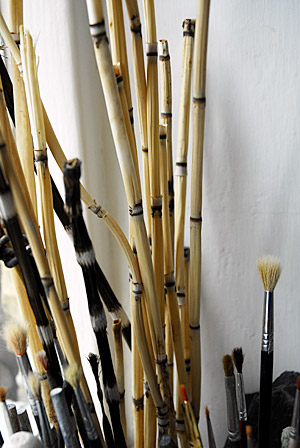Essays
“Wares which are not glazed, nor even slipped, but perhaps only burnished have quite another feel. Their body substance constitutes their surface...the pot body is made to declare itself through its own process of making.”
Philip Rawson Ceramics 1971It is a remarkable metamorphosis: from the slab of raw clay, mysteriously reacting with mineral oxides inside its plastic wrapping, to the treasured work of art, carefully positioned and lit on a plinth or shelf in the gallery, home or museum.
In the hands of Jennifer Lee, such magical transformations of material have been regular occurrences since she began her professional life as a potter in the early 1980s. Always highly disciplined and focused, working alone for intensive periods in the almost monastic silence of her studio, she has maintained a constant career trajectory and developed a solid international reputation over two decades. This is no mean feat. In a process of continuous endorsement, her pots have been exhibited or acquired for major public collections all over the world, from Sweden to New Zealand, while interest in her ceramics now gathers apace in New York, Chicago and Los Angeles. 2003 marks a significant point in Lee's career: twenty years a professional potter. The appearance of this new body of work at Galerie Besson thus provides an opportunity for reflection and celebration.
“Form pared down to the essential, containment of deep space, and breathtaking balance: this is Lee at her best. A taut and potent beauty stops us in our tracks.”There is something of the scientist, the naturalist and the anthropologist in Lee. She is energised by the prospect of new discoveries and compelled to meticulously record her findings for future reference. Some of her oxide-impregnated clays have been laid down for as long as eighteen years, and, when worked and fired, result in visual effects that contrast radically to those produced by the same mix used after only two years. Collector of natural objects, she has built up an extensive cabinet of curiosities and willingly shares her fascination for tiny discarded beetle shells, almost weightless bird bones, and a pale rock from the Mojave Desert slowly disintegrating into powdery granules. Here are the dried, banded stems of Equisetum, there a clutch of striped porcupine quills found on walks in the Tuscan hills. On my recent visit, she enthused over a newly acquired book of woven yucca sandals of the Anasazi, enthralled to discover the trace of feet in these ancient fragments. Lee captures the ephemeral in her pots, fixing the developing clay through firing, and making permanent the illusion of fugitive effects such as shimmering light and wispy vapour.
Because Lee's pots appear to have evolved subtly, almost imperceptibly over twenty years, we may be surprised to see from early photographs how different they once looked. Asymmetric silhouettes, strongly evocative of the human torso, prevailed; while edges were ripe for exploration, becoming flared, ridged, tilted or flattened into a narrow shelf. Her latest pots are predominantly symmetrical, their rims horizontal and elegant. Form pared down to the essential, containment of deep space, and breathtaking balance: this is Lee at her best. A taut and potent beauty stops us in our tracks.
Amanda Fielding
2003
Reproduced courtesy of Galerie Besson


17.8 x 27 cm

26 x 19.7 cm
Polished, haloed trace2003
14.7 x 11 cm


26 x 19.7 cm
Studio photos Jake Tilson